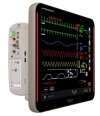The humble hospital bed joins the ranks of smart medical devices
por John W. Mitchell, Senior Correspondent | March 11, 2019
Patient Monitors
From the March 2019 issue of HealthCare Business News magazine
Paul Johnson, president, patient support systems at Hill-Rom, said that the big themes in beds are safety, patient satisfaction, and connectivity. As such, beds have evolved as advanced medical devices that need to do more than the beds of the past. For example, prevention and even healing of pressure injuries is vital, as is ensuring technology that enables early mobility. Hill-Rom is introducing incontinence detection to solve a key customer and patient need for reducing incontinence-associated dermatitis and improving patient dignity.
The company has also integrated advanced features beyond the bed alarm. These include visual cues projected on the floor to allow caregivers to know the status of a patient merely walking by the patient's room. Such features allow patients to get more rest, he said, and caregivers to spend time with patients who need attention. In the patient satisfaction realm, Hill-Rom provides built-in USB ports and mobile device storage pockets on the inside of the railing. This prevents patients from reaching far outside the bed – and potentially falling or straining when they shouldn’t – just to reach their mobile phones.
“We and our competitors are constantly raising the bar in terms of the intelligence, capabilities, and connectivity we build into hospital beds themselves,” Johnson said. “The high level of care now available in the ICU and the medical-surgical units, specifically related to where the patient spends the most time, represents the biggest and most rapid advance in hospital beds in the last ten years.”
On the interconnectivity front, think “big picture”. Hill-Rom alone, Johnson said, has more than 750,000 medical devices in the market today with connectivity capability. Combined with the new LINQ mobile wireless platform, it provides a platform to integrate staff and patient interactions with clinical systems. Such insight helps improve care team collaboration, communication, compliance, and efficiency.
“This is a great time to be in the medical device world,” Johnson said. “The rapid advancement in hospital beds and other connected technologies makes the job of caring for even the sickest patients safer and less complex, and new data connectivity solutions will give caregivers greater, faster insight. Beds are a key part of the puzzle.”
Paul Johnson, president, patient support systems at Hill-Rom, said that the big themes in beds are safety, patient satisfaction, and connectivity. As such, beds have evolved as advanced medical devices that need to do more than the beds of the past. For example, prevention and even healing of pressure injuries is vital, as is ensuring technology that enables early mobility. Hill-Rom is introducing incontinence detection to solve a key customer and patient need for reducing incontinence-associated dermatitis and improving patient dignity.
The company has also integrated advanced features beyond the bed alarm. These include visual cues projected on the floor to allow caregivers to know the status of a patient merely walking by the patient's room. Such features allow patients to get more rest, he said, and caregivers to spend time with patients who need attention. In the patient satisfaction realm, Hill-Rom provides built-in USB ports and mobile device storage pockets on the inside of the railing. This prevents patients from reaching far outside the bed – and potentially falling or straining when they shouldn’t – just to reach their mobile phones.
“We and our competitors are constantly raising the bar in terms of the intelligence, capabilities, and connectivity we build into hospital beds themselves,” Johnson said. “The high level of care now available in the ICU and the medical-surgical units, specifically related to where the patient spends the most time, represents the biggest and most rapid advance in hospital beds in the last ten years.”
On the interconnectivity front, think “big picture”. Hill-Rom alone, Johnson said, has more than 750,000 medical devices in the market today with connectivity capability. Combined with the new LINQ mobile wireless platform, it provides a platform to integrate staff and patient interactions with clinical systems. Such insight helps improve care team collaboration, communication, compliance, and efficiency.
“This is a great time to be in the medical device world,” Johnson said. “The rapid advancement in hospital beds and other connected technologies makes the job of caring for even the sickest patients safer and less complex, and new data connectivity solutions will give caregivers greater, faster insight. Beds are a key part of the puzzle.”
You Must Be Logged In To Post A CommentRegistroRegistrarse es Gratis y Fácil. Disfruta de los beneficios del Mercado de Equipos Médicos Nuevos y Usados líder en el mundo. ¡Regístrate ahora! |
|
















